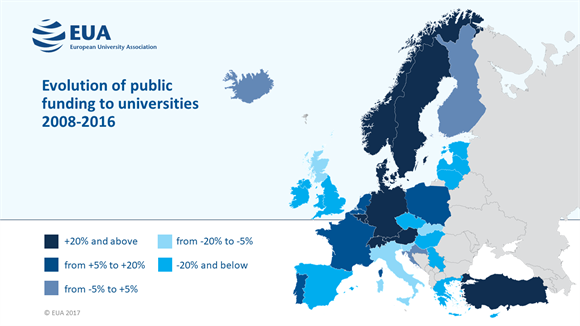A European University Association analysis of public funding has revealed that many countries in Europe have failed to repair cuts made to higher education since the financial crisis, despite experiencing economic recovery. Spain, Italy and Ireland were among those with lower levels of direct public funding in 2016 than in 2008.
News and business analysis for Professionals in International Education
Have some pie!
University public funding recovery is “slow and fragile” says EUA
 A map of how public funding
to universities in 2016 changed compared to 2008.Image: EUA
A map of how public funding
to universities in 2016 changed compared to 2008.Image: EUA The EUA Public Funding Observatory evaluated 34 higher education systems across Europe and found that just 14 had higher funding in 2016 than in 2008, including Luxembourg, Austria, Germany and Switzerland.
In 2015-2016, the largest public funding investments were made in Turkey (18%), Austria (8%), Luxembourg (8%), Croatia (7%) and Iceland (7%), while the largest cuts were applied in Greece (-16%), Slovenia (-9%) and Czech Republic (-6%).
Despite the positive funding growth in Turkey, the report noted however that it is a “growing system under pressure”, as the increase in funding continues to lag behind a threefold expansion of student numbers from 2008-2016.
19 higher education systems still had lower levels of direct public funding in 2016 than in 2008
It also revealed Germany, which recently surpassed its goal of hosting 350,000 international students by 2020, increased its funding for universities in 2016 by 4.1% – its highest increase in three years.
Six countries including Norway and Sweden, are reportedly following “sustainable” funding trajectories after demonstrating superior public funding growth to that of student enrolments in 2016.
Others such as Denmark and the Netherlands were found to be under higher pressure due to rising student enrolment, and funding growth that is not fast enough to cater to a larger student population.
This echoes recent reports that a boom in student enrolments in the Netherlands, coupled with a lack of student housing led to some international students resorting to staying in campsites.
The Observatory data also showed that 19 higher education systems had lower levels of direct public funding in 2016 than in 2008.
Of these, seven higher education systems, including those in Ireland and Spain, are considered to be “in danger” as a result of cutting funds while facing growing student populations.
“Once university funding is cut, it takes a long time to catch up”
The report revealed that public funding to Irish universities declined by 37% between 2008-2016, while student numbers increased by 23% during the same period.
In Spain, public funding dropped by 16% in 2008-2016, while student numbers grew by 21%.
The UK has also cut back on higher education despite experiencing economic growth. However, figures in the report exclude publicly subsidised student loans, which England and Wales have shared a significant shift towards during the period.
Meanwhile, Scotland displayed a comparatively slower funding erosion as the student population continues to grow and Northern Ireland revealed significant funding cuts.
EUA’s director of Governance, Funding and Public Policy Development Thomas Estermann explained that once university funding is cut, it takes a long time to catch up.
“2012 was the year of deepest crisis for universities in Europe. A certain degree of recovery since then can be detected, as more countries started to re-invest in their universities after 2012. However, recovery remains slow and fragile.”
An ‘aggravating decline’ in funding was observed in the Balkans
“If Europe sees more economic growth, we need to seize the opportunity to invest in higher education and set the stage for long-term sustainable funding trends,” he added.
In terms of academic staff, the report revealed a challenging situation for Irish and Northern Irish universities, which have experienced growing student numbers but have had to reduce academic staff between 2008-2016, by 3% and 8% respectively.
While funding figures for 2017 were only available for 21 of the 34 higher education systems in the sample, 15 were found to have increased funding for universities by more than 1%.
Signs of recovery of public investment in universities were observed in Finland and Croatia, while some “cautious steps forward” were made in Scandinavia, Belgium, France and the Netherlands.
Meanwhile “aggravating decline” in public funding for universities was observed in the Balkans, as well as in Ireland and Spain.
Addressing the findings in a webinar, Estermann said that since 2008, there are still a wide number of systems that are not sufficiently funding their institutions.
“It’s a very challenging situation with a lot of negative impacts. We are making a drastic call for change and more investment at a European level; that is our key message,” he said.
The report and EUA’s campaign ‘EU funding for universities’ conclude that more funding is needed both at the EU level to improve the efficiency of the Framework Programme and at the national level to enable universities to contend and remain attractive.
Still looking? Find by category:


